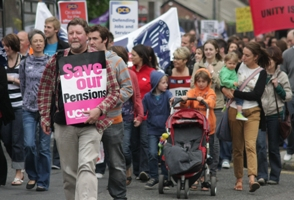Millions Set to Strike in Britain

As many as 2.5 million public sector workers will strike across Britain on November 30. More than 20 unions have voted to join the massive strike, from national giants such as Unison and UNITE to tiny regional unions in Northern Ireland, Wales, and Scotland.
Even the “head teachers” (school principals) have voted overwhelmingly to strike for the first time in their history. The one-day action follows a June 30 strike by 600,000 members of four public sector unions.
The issue is the government’s plan to reduce public employee pension costs by $2.9 billion a year, though unions already accepted “reforms” in 2007 that saved the government 14 percent a year. The plan will make public employees work longer, contribute more, and receive less.
The government claims it is willing to negotiate further on details before the final legislation is introduced in Parliament.
The strike will affect services in national and local government, all levels of education including universities, and the National Health Service.
PAYING MORE FOR LESS
If the bill goes through, workers on the job will have to contribute an average of $101 more per month to their pensions. This is on top of a public sector wage freeze since 2009, amounting to an 11.6 percent drop in purchasing power.
Benefits will be reduced by changing from a “final year” base to a “career” base and by altering the inflation calculator—a measure also under discussion for Social Security in the United States. One union estimates the latter cut could cost its members an average of $26,220 over 20 years. The Financial Times calls it “equivalent to a 3 percent increase in income tax.”
But even to get this lower pension you will have to work longer. Local government workers at least 46 years old will see their eligibility rise from age 65 to 66. Those under 35 will have to wait until 68 to get a pension. From Greece to the U.K. to the U.S., the austerity consensus is the same.
In early November the government made minor concessions in hopes of heading off the strike. Workers within 10 years of taking a pension will still be eligible at 65. But the basic plan remained unchanged and union leaders indicated they would go ahead unless much bigger concessions were offered.
Although pensions are the focus of this strike, dissatisfaction runs deeper. In addition to falling real wages, the cuts of half a million public jobs already well under way have meant deteriorating working conditions and growing unemployment, already at 8 percent. Services to the public are affected, notably by closings of emergency and other hospital services, with threats of more to come.

SUPPORT LABOR NOTES
BECOME A MONTHLY DONOR
Give $10 a month or more and get our "Fight the Boss, Build the Union" T-shirt.
A recent survey found that 64 percent of central government employees and 54 percent in local government would not recommend working in the public sector.
RUINING THE PLAN
“I can ruin the government’s plan,” sang The Strawbs in their 1973 hit, “I’m Part of the Union.” And, indeed, 1973 and 1974 saw massive strikes bring down the Conservative government and with it the hated Industrial Relations Act (which removed unions’ traditional immunity to litigation or damages resulting from strikes).
No doubt many workers and union leaders today hope they can do the same to the pension plan. While a one-day strike is unlikely to fulfill that wish by itself, it may help stir up resistance across the labor movement.
As yet, there are no official plans for a follow-up other than a pending lawsuit by the civil service union. It is likely, however, that pressure from below will produce further action by some unions.
To head off public support, the government has portrayed public workers as greedy. But even the Hutton Commission report on which the government’s plan is based denied that public pensions were “gold-plated.” The median payment is $8,953 a year, while the average for a woman in local government is $4,157—well below the poverty line.
The Hutton report’s projections also showed that even under the current provisions, pension costs would fall over the next five decades.
The “greedy worker” line may backfire. While most workers saw their incomes fall behind inflation rates of 4-5 percent in the last couple of years, CEOs saw their annual earnings this year rise by 43 percent to $6.2 million.
Union leaders have called the government’s pension changes “a tax on public sector workers to pay for the mess made by the banks.” With 18 millionaires sitting in the Cabinet, talk of greedy workers might not carry the day when 2.5 million of them take to the streets.
Kim Moody, a former Labor Notes staffer, teaches industrial relations at the University of Hertfordshire and will be on strike November 30.





